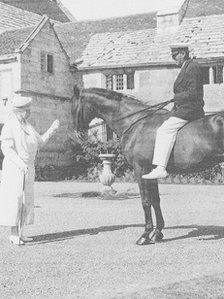Remembering Hampshire and Isle of Wight's real warhorses
- Published

Warrior and Gen Jack Seely returned to the Isle of Wight after World war I
Steven Spielberg's film War Horse has sparked renewed interest in the real-life horses from Hampshire and the Isle of Wight which survived the carnage of World War I.
One of the most famous was the bay thoroughbred, Warrior, reared on the Isle of Wight.
His owner, Gen Jack Seely formed a lifelong bond with the horse, training him in the waves of Brook Beach before taking him to the battlefields of France when war broke out in 1914.
Both the horse and rider survived some of the Great War's most infamous battles: Ypres, the Somme and Paschendale. Warrior's bravery earned him a reputation as "the horse the Germans couldn't kill".
Gen Seely's grandson, Patrick Seely, still lives at Mottistone Manor on the Isle of Wight.
He said: "They went through all those adventures together and survived. They grew old together and knew each other from cradle to grave.
"I think it's a wonderful story which encapsulates that era, both the drama and horror of what went on and the heroism."
'Horses suffered'
Warrior was one of 1.3 million horses which took part in World War I. Many of them passed through a giant military depot in Hampshire.
The Romsey Remount Depot, which had been all but forgotten when accounts were unearthed by local historian Phoebe Merrick, is now the subject of an exhibition at the town's King John's Museum.

Tens of thousands of horses went through Romsey Remount Depot
The 500-acre site housed 2,000 staff and processed tens of thousands of wild horses from all over the world.
Horses and their military handlers were trained before being despatched to the battle fronts.
During World War I horses were still the primary means of transporting men and equipment. Only about one in 10 horses survived the war.
Ms Merrick said: "I was stunned, it was an enormous place. Horses were selected to do specific jobs at the front and they suffered as badly as the men did."
It is thought 50,000 horses a year were shipped in through Southampton docks.
Ms Merrick came across reports of a stampede of horses through the high street when a group escaped down an unblocked road.
With the buildings removed after the war, memories of the Romsey depot faded, although hardcore from the site was used as foundations in the town's war memorial park.
Bag of sugar
Among those which survived the war, another horse called Warrior later became a familiar figure around Southampton.
After seeing action during the early advances into France, and later being injured by shrapnel, the grey charger became a police horse in the city.
Their experience of the noise of battle meant it was not uncommon for former military horses to be used by police.
After the war, Warrior was bought by animal lover Hilda Moore and donated to the police - on condition he was returned to her once a year to receive a bag of sugar.
When he died in 1935 Warrior was given a civic burial and laid to rest on the edge of the golf course at Southampton Sports Centre.
His hoof was preserved and later used as an inkwell by the chief constable.
Former mayor Jack Candy has called for a memorial to Warrior and all the horses which took part in World War I to be erected in the city.
He said: "For the same reason we want to recognise the men and women who served the country and died, the horses are also important.
"He was very popular among the people of the city, a wonderful horse who should be recognised for his contribution."